Wayang golek
Wayang golek (Sundanese: ᮝᮚᮀ ᮍᮧᮜᮦᮊ᮪) is one of the traditional Sundanese puppet arts from West Java, Indonesia. in contrast to the wayang art on other Javanese islands that use leather in the production of wayang, wayang golek is a wayang art made of wood. Wayang Golek is very popular in West Java, especially in the Pasundan land area.[1][2] Today, wayang golek has become an important part of Sundanese culture in West Java.
| Wayang Puppet Theatre | |
|---|---|
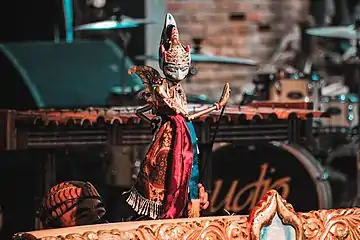 | |
| Country | Indonesia |
| Criteria | Performing arts, Traditional craftsmanship |
| Reference | 063 |
| Region | Asia and the Pacific |
| Inscription history | |
| Inscription | 2008 (3rd session) |
| List | Representative List |
 Wayang Kulit, Wayang Golek, Wayang Klithik | |
| Wayang golek | |
|---|---|
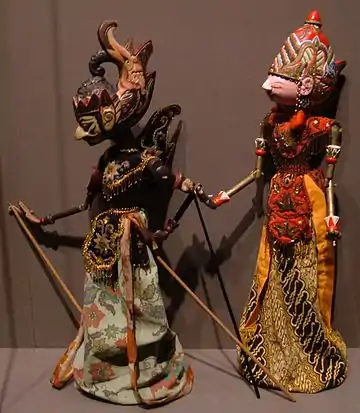 | |
| Types | Traditional puppet thatre |
| Ancestor arts | Sundanese people |
| Originating culture | Indonesia |
On November 7, 2003, UNESCO designated wayang puppet theatre, which is the flat leather shadow puppet (wayang kulit) and the three-dimensional wooden puppet (wayang golek or wayang klithik) theatre from Indonesia as one of the Masterpieces of the Oral and Intangible Heritage of Humanity.[3]
History
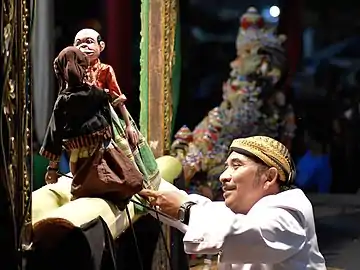
According to some sources, the history of the Wayang Golek began in the 17th century. Initially, the Wayang Golek art emerged and was born in the north coast of the island of Java especially in Cirebon, the Wayang Golek used is the Wayang Golek Cepak in the form of a papak or flat head. According to legend, Sunan Suci used this Wayang Golek to spread of Islam in the community. At that time, the Wayang Golek performance still used Javanese in its dialogue. The Wayang Golek art began to develop in West Java during the expansion of the mataram sultanate.
Wayang Golek began to develop with Sundanese as a dialogue. In addition to being a medium for spreading religion, Wayang Golek serves to complement thanksgiving or ruwatan events. At that time the puppet show was still without using sindhen as an accompanist. Wayang Golek began using the accompaniment of sinden in the 1920s. Until now the Wayang Golek continues to develop as entertainment for the community, especially in Sundanese land.
In this Wayang Golek show, as with other wayang shows, plays and stories are played by a puppeteer. The difference is the language in the dialogue that is brought is Sundanese language. The standard and the wayang Golek are also the same as wayang kulit, for example in the Ramayana and Mahabarata stories. But the difference is in the character of the clown, the naming and form of the clown have their own version, namely the Sundanese version.
In addition to the Ramayana and mahabarata stories, there are also stories and carangan stories. In this wayangan story, the mastermind makes his own story line which is usually taken from folklore or daily life. in the story carangan usually contains moral messages, criticism, humor and others - others. In the story carangan is not only used to develop the story, but also to measure the quality of the mastermind in making the story. In this puppet show besides accompanied by sinden also accompanied by Sundanese gamelan such as saron, peking, celery, bonang, kenong, gong, rebab, kempul xylophone, drums and culant drums.
In its development, Wayang Golek remains one of the traditional arts of the pride of the people of West Java. Proven Wayang Golek still colors various events such as ruwatan, thanksgiving and other large events. In addition, some artists continue to develop it with a number of additional creations to make it look attractive and stay sustainable without eliminating the grip in it.
Gallery
- Some Sundanese Wayang Golek Figures (3D Wooden Puppet)
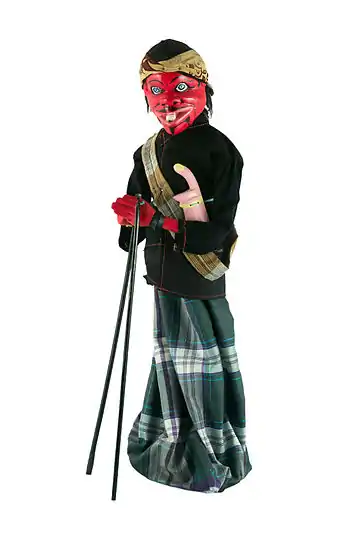
.jpg.webp)
.jpg.webp) Wayang Golek (3D Wooden Puppet), Indonesia in 2004
Wayang Golek (3D Wooden Puppet), Indonesia in 2004
 Pair of Wayang Golek (3D Wooden Puppet) from Java, Indonesia on display at the Asian Art Museum in San Francisco, California. 2007. Left: Gatotkaca Right Karna
Pair of Wayang Golek (3D Wooden Puppet) from Java, Indonesia on display at the Asian Art Museum in San Francisco, California. 2007. Left: Gatotkaca Right Karna.jpg.webp)
- Some Javanese Wayang Golek Figures (3D Wooden Puppet)

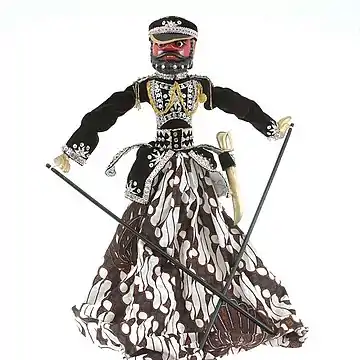

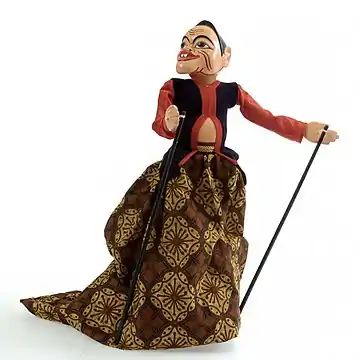
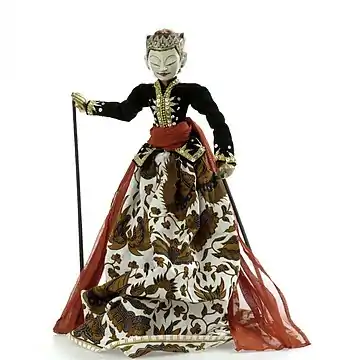
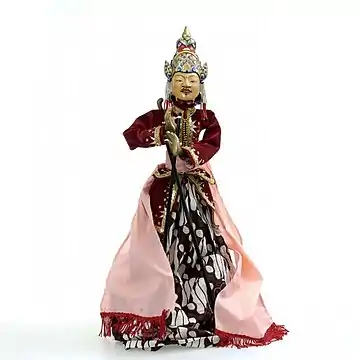
See also
- Wayang
- Wayang kulit
- Wayang wong
- Wayang klitik
References
- "Wayang Golek Kesenian Tradisional Dari Jawa Barat". negerikuindonesia.com (in Indonesian). Retrieved 2020-06-29.
- "Wayang Golek Cepak Warisan Tak Lekang Waktu Bagi Generasi Muda". kompas.com (in Indonesian). Retrieved 2020-07-08.
- "Wayang puppet theatre - intangible heritage - Culture Sector - UNESCO". ich.unesco.org. Retrieved 2017-11-09.
